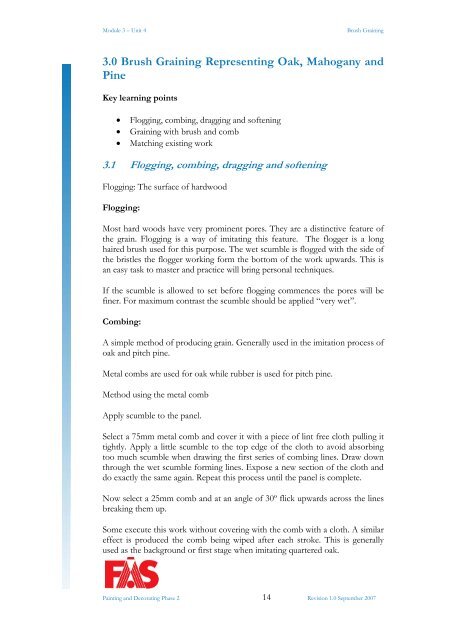TRADE OF PAINTING & DECORATING - eCollege
TRADE OF PAINTING & DECORATING - eCollege
TRADE OF PAINTING & DECORATING - eCollege
Create successful ePaper yourself
Turn your PDF publications into a flip-book with our unique Google optimized e-Paper software.
Module 3 – Unit 4 Brush Graining<br />
3.0 Brush Graining Representing Oak, Mahogany and<br />
Pine<br />
Key learning points<br />
• Flogging, combing, dragging and softening<br />
• Graining with brush and comb<br />
• Matching existing work<br />
3.1 Flogging, combing, dragging and softening<br />
Flogging: The surface of hardwood<br />
Flogging:<br />
Most hard woods have very prominent pores. They are a distinctive feature of<br />
the grain. Flogging is a way of imitating this feature. The flogger is a long<br />
haired brush used for this purpose. The wet scumble is flogged with the side of<br />
the bristles the flogger working form the bottom of the work upwards. This is<br />
an easy task to master and practice will bring personal techniques.<br />
If the scumble is allowed to set before flogging commences the pores will be<br />
finer. For maximum contrast the scumble should be applied “very wet”.<br />
Combing:<br />
A simple method of producing grain. Generally used in the imitation process of<br />
oak and pitch pine.<br />
Metal combs are used for oak while rubber is used for pitch pine.<br />
Method using the metal comb<br />
Apply scumble to the panel.<br />
Select a 75mm metal comb and cover it with a piece of lint free cloth pulling it<br />
tightly. Apply a little scumble to the top edge of the cloth to avoid absorbing<br />
too much scumble when drawing the first series of combing lines. Draw down<br />
through the wet scumble forming lines. Expose a new section of the cloth and<br />
do exactly the same again. Repeat this process until the panel is complete.<br />
Now select a 25mm comb and at an angle of 30º flick upwards across the lines<br />
breaking them up.<br />
Some execute this work without covering with the comb with a cloth. A similar<br />
effect is produced the comb being wiped after each stroke. This is generally<br />
used as the background or first stage when imitating quartered oak.<br />
Painting and Decorating Phase 2 14 Revision 1.0 September 2007
















